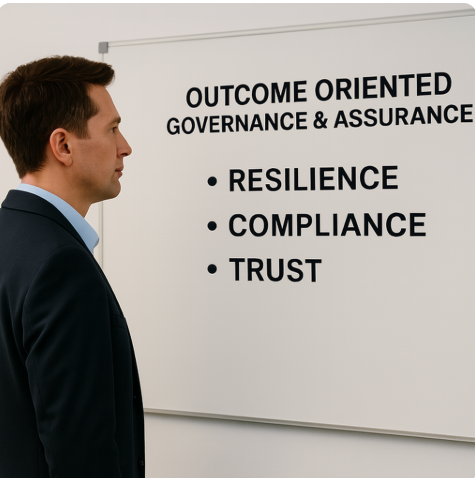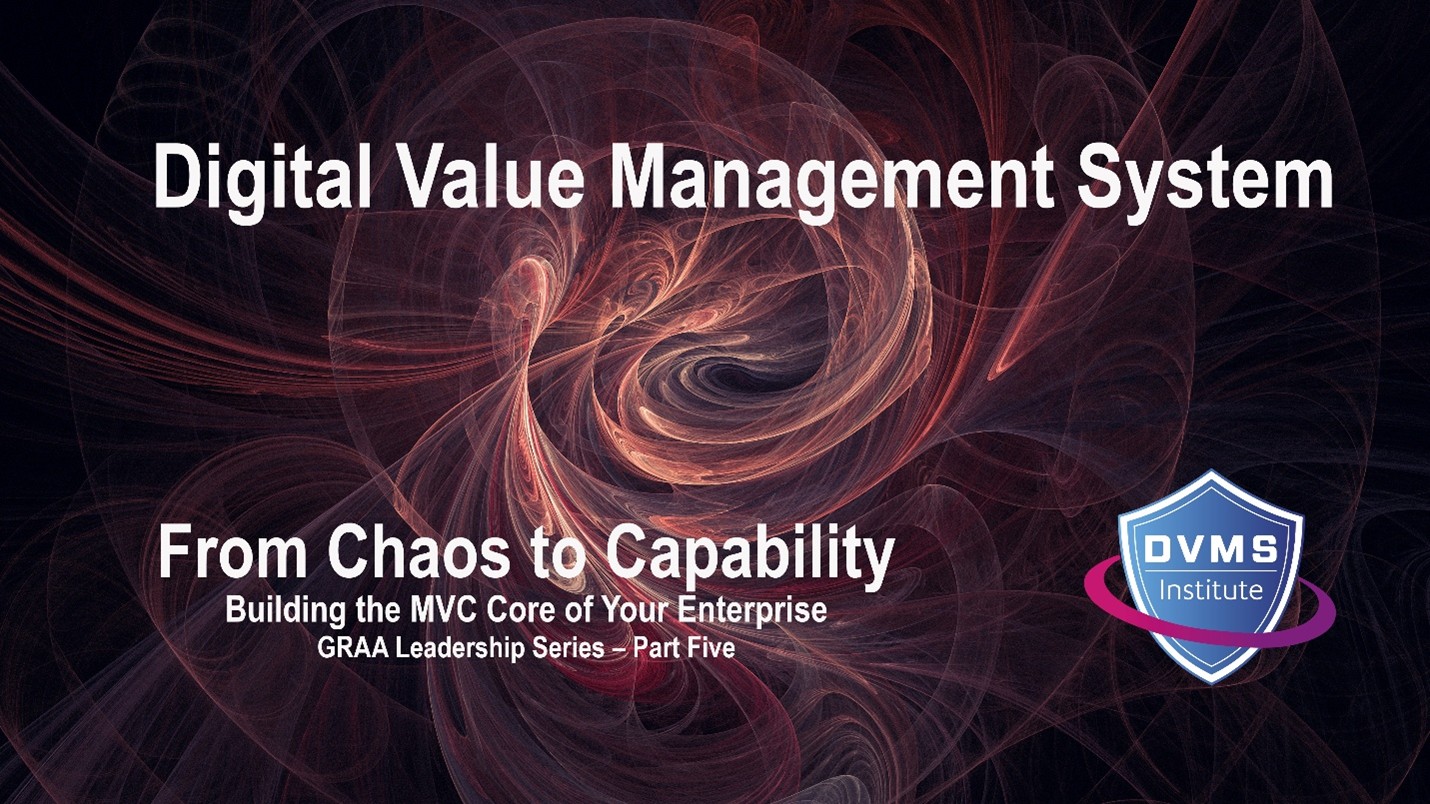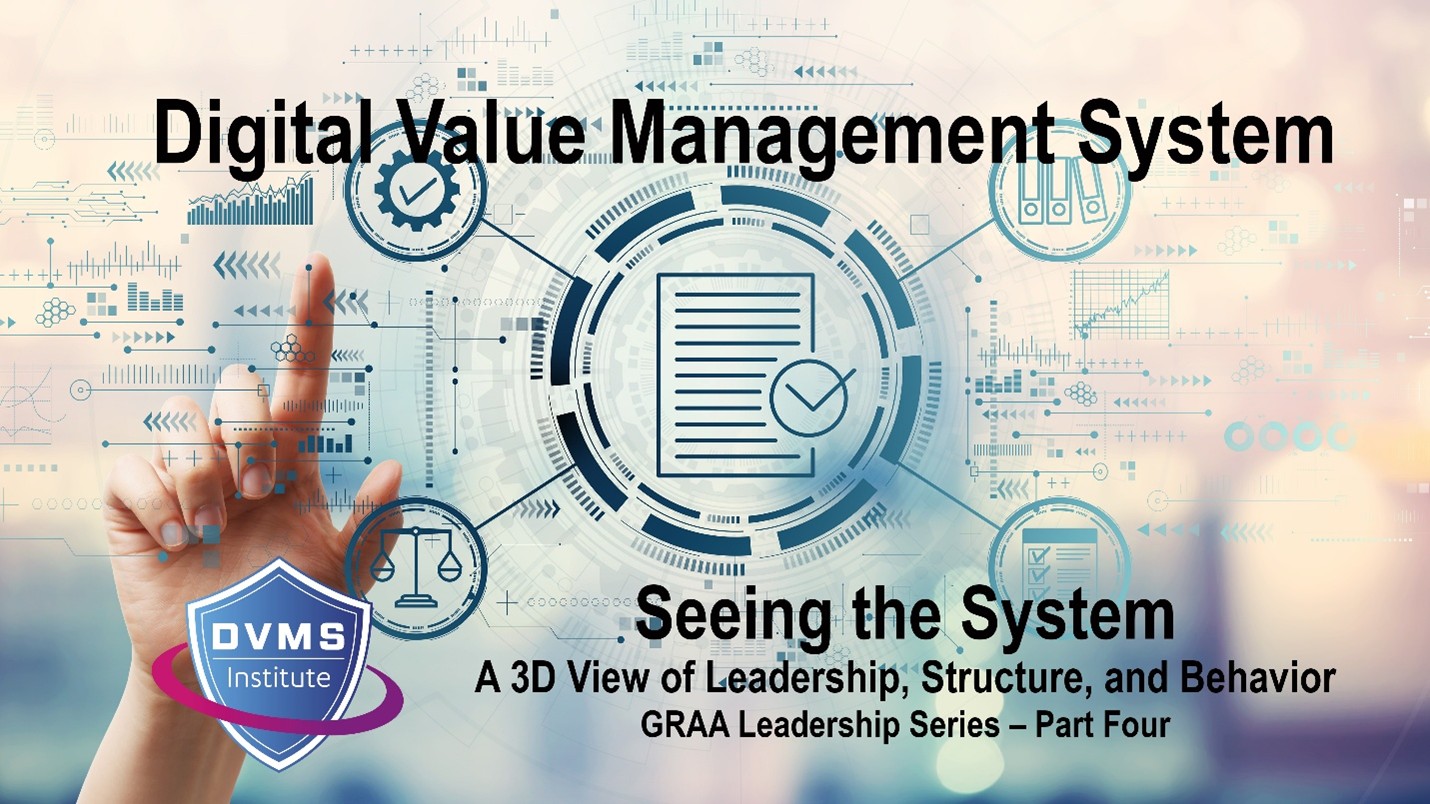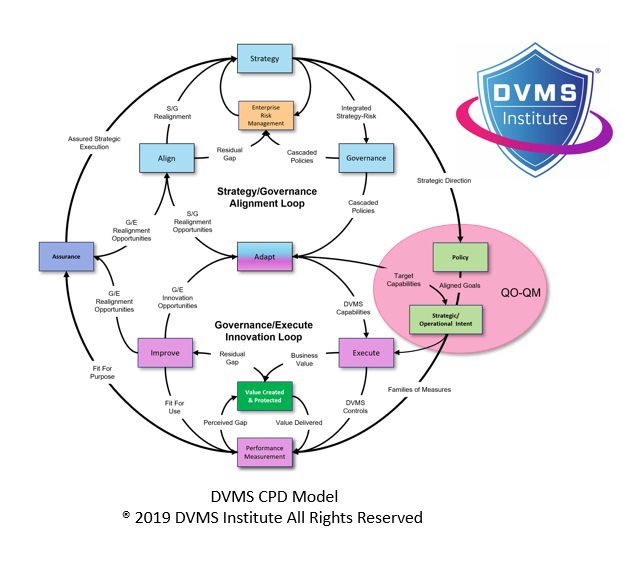Why Enterprises Must Implement an Integrated, Adaptive, and Outcomes-Oriented Governance and Assurance System
Rick Lemieux – Co-Founder and Chief Product Officer of the DVMS Institute
Introduction: Governance at a Crossroads
The modern business environment is defined by volatility, uncertainty, complexity, and ambiguity. Digital ecosystems span global supply chains, artificial intelligence is reshaping risk, and regulators are demanding more accountability from leadership. In this context, traditional governance and assurance systems are proving inadequate. They are often fragmented across functions, rigid in their structures, and focused narrowly on compliance. These approaches may meet minimal obligations, but they fail to ensure that organizations can deliver value, maintain trust, and sustain performance in a turbulent environment. What is needed is a governance and assurance system that is integrated across silos, adaptive to change, and focused on outcomes such as resilience, compliance, and trust.
The Problem with Traditional Governance Models
Traditional governance and assurance systems evolved during an era when risks were relatively static, regulations were predictable, and business operations were less globally interconnected. In this context, fragmented oversight—such as separate governance tracks for IT, risk, and compliance—could function adequately. However, in today’s digital and highly interdependent environment, this approach creates serious blind spots.
When IT service management, cybersecurity, enterprise risk, and audit operate independently, leaders lack a holistic view of organizational risk and performance. Duplication of controls wastes resources, while inconsistent reporting creates confusion. Most concerning, systemic risks often fall through the cracks until they erupt into crises. This is why organizations that appear compliant on paper are frequently the ones that are blindsided by large-scale cyberattacks, operational failures, or cultural breakdowns. A fragmented, compliance-first mindset simply cannot deliver resilience in a world defined by systemic risk.
Why Integration Is Critical
An integrated governance and assurance system unifies these siloed functions into a coherent overlay. Integration creates a common language and shared framework across ITSM, GRC, cybersecurity, and enterprise risk. This provides boards and executives with a 360-degree view of risks, controls, and performance outcomes.
The benefits of integration are substantial. First, it eliminates redundancy by harmonizing risk assessments, control testing, and assurance mechanisms. Second, it provides clarity and transparency, enabling leaders to connect strategic objectives to operational execution and assurance. Finally, integration fosters accountability: when functions are unified, it becomes clear who is responsible for delivering outcomes and how those outcomes are measured.
In practice, integration also strengthens collaboration. IT teams, compliance officers, risk managers, and executives can align around shared priorities rather than competing agendas. This creates efficiency and reduces the friction that so often undermines governance effectiveness.
The Imperative of Adaptability
Integration provides the foundation, but adaptability ensures longevity. Risks today evolve at unprecedented speed. Artificial intelligence introduces ethical and operational concerns; geopolitical instability disrupts supply chains; and new regulations, such as the EU’s Digital Operational Resilience Act (DORA) or the U.S. SEC’s cyber disclosure rules, demand rapid compliance adjustments. A governance system that cannot adapt to these shifts is destined to fail.
Adaptive governance and assurance systems are designed to evolve iteratively. They rely on continuous monitoring, real-time data, and phased improvement cycles. Rather than conducting risk assessments annually, adaptive systems continually assess and recalibrate. Rather than waiting for audits to reveal weaknesses, adaptive systems detect issues in real time and respond dynamically.
Crucially, adaptability also means anticipating the unexpected. Whether facing a sudden cyberattack, a natural disaster, or a global health crisis, organizations must be able to absorb shocks, adjust operations, and continue delivering critical services. Adaptability reframes governance from static oversight to dynamic capability. It ensures that governance remains relevant in fast-moving, uncertain environments.
From Activities to Outcomes
Perhaps the most transformative dimension of modern governance is its focus on outcomes rather than activities. Traditional governance systems often reduce to box-ticking exercises, such as completing audits, issuing reports, or documenting controls. While these activities may demonstrate compliance, they do not guarantee resilience, trust, or performance.
An outcomes-oriented governance and assurance system flips the equation. The central question shifts from “Did we complete the checklist?” to “Are we resilient, compliant, and trusted enough to deliver our mission under stress?” This focus forces organizations to measure what truly matters.
For example, instead of tracking only the number of security patches applied, outcomes-oriented systems measure recovery times, customer satisfaction during crises, and the ability to sustain critical business services. Instead of focusing solely on regulatory deadlines, they measure how governance strengthens trust among customers, partners, and regulators. Compliance remains essential, but it becomes a byproduct of resilience rather than the primary objective.
The Role of Culture in Driving Outcomes
No governance and assurance system can succeed without culture. Policies, frameworks, and platforms are essential, but it is culture—the shared values, beliefs, and behaviors of people—that determines whether outcomes are achieved.
A culture-driven governance system embeds resilience, accountability, and trust in daily operations. Employees understand their role in protecting digital value, leaders model transparency and ethical decision-making, and collaboration is rewarded rather than punished. Such a culture transforms governance from a bureaucratic burden into a living capability that enables organizational agility.
Culture also drives adaptability. In organizations that value learning and collaboration, employees report issues promptly, share lessons learned, and experiment with new solutions. By contrast, in rigid, compliance-only cultures, employees may hide problems or resist change, undermining resilience. Embedding a culture of accountability and trust ensures that governance outcomes are achieved not by mandate but by collective practice.
Benefits Across Stakeholders
The adoption of an integrated, adaptive, and outcomes-oriented governance and assurance system creates value across all stakeholders:
- Boards and Executives gain clarity and confidence that risks are being managed holistically and that resilience is measurable.
- Regulators and Auditors see tangible evidence that the organization is not just compliant but also resilient and adaptive.
- Customers and Partners trust that digital services will remain secure and reliable, even under stress.
- Employees experience empowerment, knowing their contributions strengthen resilience and trust.
- Investors and Shareholders benefit from reduced risk exposure, enhanced reputation, and stronger long-term performance.
In this way, outcomes-oriented governance aligns the interests of all stakeholders, creating a virtuous cycle of trust, accountability, and performance.
Steps Toward Implementation
Implementing such a governance and assurance system requires deliberate steps:
- Unify Frameworks: Map existing ITSM, GRC, and cybersecurity programs to a shared overlay, identifying overlaps and gaps.
- Embed Adaptability: Introduce continuous monitoring, phased improvement models, and agile governance practices.
- Define Outcomes: Shift metrics from activity-based checklists to outcomes such as resilience, compliance, and trust.
- Drive Cultural Change: Use leadership modeling, training, and cultural assessments to embed governance principles into daily practice.
- Leverage Technology: Implement platforms that support integration and real-time assurance but ensure they serve governance outcomes, not bureaucracy.
The Risk of Inaction
The cost of failing to adopt integrated, adaptive, and outcomes-oriented governance is steep. Fragmented systems leave organizations vulnerable to systemic risks. Static governance models cannot keep pace with evolving threats. Activity-driven compliance creates a false sense of security, leaving organizations unprepared for crises.
History is filled with examples of organizations that appeared compliant yet collapsed under stress—whether through cyberattacks, financial mismanagement, or cultural failures. In every case, the absence of integration, adaptability, and outcome orientation contributed to the downfall. Inaction today will only magnify risks tomorrow.
Conclusion: Governance as a Strategic Advantage
Every organization must implement an integrated, adaptive, and outcomes-oriented governance and assurance system to survive and thrive in today’s complex environment. Integration breaks down silos, creating transparency and efficiency. Adaptability ensures that governance evolves in response to risks and opportunities. An outcomes-oriented focus shifts attention from checklists to what truly matters: resilience, compliance, and trust.
This is not simply about compliance; it is about strategy. In the digital age, governance and assurance are no longer support functions—they are strategic capabilities that determine whether organizations can sustain performance, protect value, and maintain trust. Organizations that adopt this model will transform governance from a burden into a source of competitive advantage, enabling them not only to withstand disruption but also to emerge stronger from it.
About the Author

Rick Lemieux
Co-Founder and Chief Product Officer of the DVMS Institute
Rick has 40+ years of passion and experience creating solutions to give organizations a competitive edge in their service markets. In 2015, Rick was identified as one of the top five IT Entrepreneurs in the State of Rhode Island by the TECH 10 awards for developing innovative training and mentoring solutions for boards, senior executives, and operational stakeholders.
Traditional best-practice approaches to IT Service Management (ITSM), Governance, Risk and Compliance (GRC), and Cybersecurity are insufficient to manage the resilience, compliance, and trust requirements of today’s complex digital ecosystems.
The DVMS Cyber Resilience Professional Certified Training programs teach Organizations the skills to evolve any best-practice program into an integrated, adaptive, and culture-driven Digital Value Management Governance and Assurance System® (DVMS) capable of transforming systemic cyber risk into operational resilience.
For ITSM
The DVMS elevates ITSM from a process-aligned service-delivery program into an integrated, adaptive, and culture-driven governance and assurance overlay system, ensuring the delivery of high-performance and resilient digital business outcomes.
For GRC
The DVMS elevates GRC from a compliance checklist activity to an integrated, adaptive, and culture-driven governance and assurance overlay system, ensuring the resilient, compliant, and trusted digital business outcomes regulators expect.
For Cybersecurity
The DVMS elevates any cybersecurity program (NISTCSF, ISO, etc.) from a control-centric defense program into an integrated, adaptive, and culture-driven governance and assurance overlay system, transforming systemic cyber risk into compliant and trusted operational resilience.
By adopting a DVMS, organizations are positioned to:
- Maintain Operational Stability Amidst Constant Digital Disruption
- Deliver Digital Value and Trust Across A Digital Ecosystem
- Satisfy Critical Regulatory and Certification Requirements
- Leverage Cyber Resilience as a Competitive Advantage
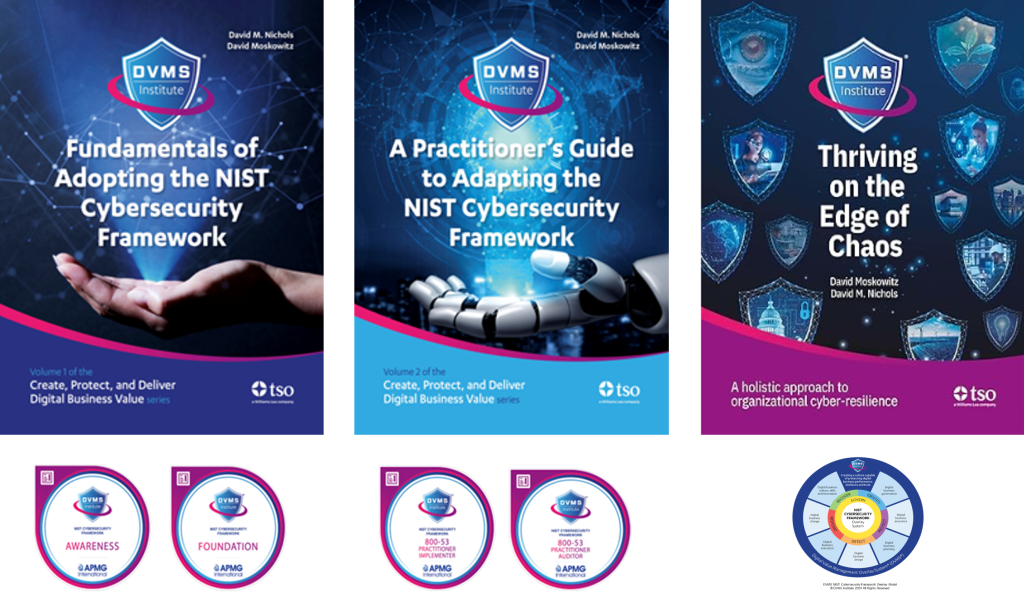
DVMS Explainer Videos
- Architecture Video: David Moskowitz explains the DVMS System
- Case Study Video: Dr. Joseph Baugh Shares His DVMS Story.
- Overlay Model – What is an Overlay Model
- MVC ZX Model – Powers the CPD
- CPD Model – Powers DVMS Operations
- 3D Knowledge Model – Powers the DVMS Culture
- FastTrack Model – Enables A Phased DVMS Adoption
Digital Value Management System® is a registered trademark of the DVMS Institute LLC.
® DVMS Institute 2025 All Rights Reserved

